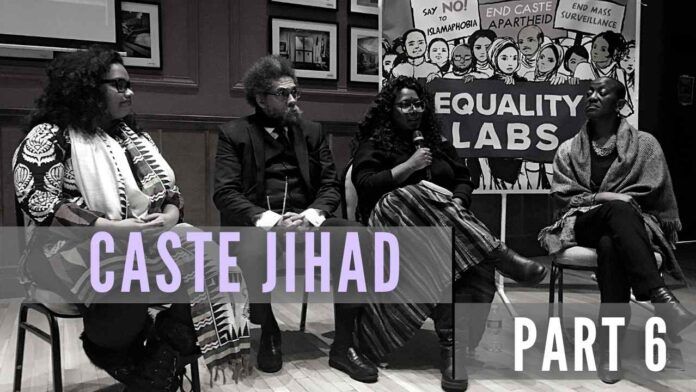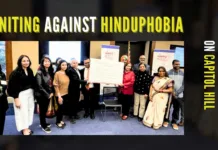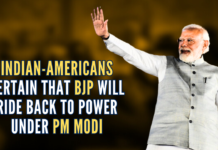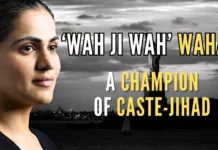
The previous 5 parts of the article can be accessed here Part 1, Part 2, Part 3, Part 4, Part 5. This is the sixth part
Origin of caste in America
The earlier parts (1-5) of the “Caste-Jihad” covered how the ancient Varna system was tainted during colonial times as a hierarchical “caste” system. That got further politicized in independent India and regrettably took a turn for the worse as a “vote-bank” to win the elections. This politically motivated jihad led to a more complex caste-based reservation/ quota system while caste-based discrimination was unlawful. This continues to date and, in my view, it has gone too far toward ‘reverse discrimination’ against the previously deemed “upper-caste” people. The whole Indian policy needs to be recalibrated if there is a political will.
In this part, we fast forward to the caste-jihad in the United States which has become a topic of interest both for the academia and media. It has taken deeper roots and gained greater visibility in the last 5 years or so but its origin goes back a bit further as discussed later. Personally, I have been in the U.S. since 1978 but never heard of it until the last couple of years. I know many others who would say the same. It may have been a topic of scholarly interest but by no means do we talk about it at work or in a social setting. It was beginning to fade away in India and certainly, most of us left it behind when we immigrated.
My definition of caste-jihad in the present context of the U.S. includes legal maneuvering, linguistic twists, and turns, journalistic activism, politically convenient comparison with the racial issues in the U.S., etc. The caste issue has become somewhat seductive for the activists and media to write the narratives and/ or frame arguments for satisfying their leftist ideology against India and/ or Hindus, increased notoriety, and/ or personal gains. For example, the lawyers stretch their imagination to define “caste” under Title VII which prohibits job discrimination on the basis of race, color, religion, sex, and national origin. They have included the dark skin, ancestry, and/ or the caste itself in their allegations but no known legal case is successful yet.
As I researched the issue, there was a floodgate of articles with the caste pervading the higher education institution more than I could imagine. I was troubled and surprised having spent all my career in higher education and never hearing about it. Some institutions have already chosen to include caste as a protected category in their discrimination policies. A pending court case alleging race-based discrimination in the high-tech industry (Cisco) and another recent allegation against the BAPS temples have been in the media. We will touch on all of them later.
It appears that the newfound interest in the caste issue in the U.S., with its alleged origin in Hinduism, has a common denominator pointing to the Equality Labs (EL) and its infamous 2018 survey. Surprisingly, the EL survey has been quoted in almost every published article even though there are more recent and robust surveys by Carnegie Endowment since then[1]. While there are many inequalities in the stated mission of EL, founded in 2014, which I discussed earlier but its co-founder, Thenmozhi Sounderarajan (TS), deserves the digital space[2]. The readers should know who she is and her activism, the obsession with the caste issue, and the storytelling skills she used to take her ideas to the evolution of EL.
Who is TS?
Born in Los Angeles, TS was a community organizer and activist from a young age and was inspired to fight discrimination against the Indian Dalit community (formerly known as untouchable). Her mother is a Dalit and TS must have heard stories from her of the atrocities she may have faced in India., She organized the country’s first national digital storytelling program at Berkley where she studied. Later she took this idea to establish a technology collective called Third World Majority in 2001 with five other young women of color including her own sister. She went on to create Equality Labs in 2014 which brings together the many strands of her activism.
Reportedly, her interest in digital storytelling has its origin in her own heritage as a Tamil Dalit. TS should have made up her mind early on to keep the Dalit connection alive with her Indian heritage. She still keeps it breathing with even greater intensity to incite media and academia. Her motivation may also have related to her statement, according to her Wikipedia biography, “she also faced discrimination from almost all of the Indian professors in her campus, who refused to advise her on projects.” Now, Sounderarajan travels around the country making presentations using her storytelling skills, offering training on how to detect casteism in the hiring of South Asians who allegedly have casteism in their blood, and advocating for policies to make caste a protected category under discrimination policies. Initially, she offered high-tech training for people from traditionally disenfranchised groups to tell their own stories, in their own way. Now she is using the same skills to tell the stories to the world in her relentless activism and it is making a difference.
Why a surge in the caste issue?
In recent years, the number of Indian (or South Asians) students coming for higher education and H1B visa holders to meet the increasing workforce demands of the high-tech industry has grown many folds in the U.S. On the other hand, India’s reservation /quota system has enabled many more students from the SC / ST/ OBC to be admitted and educated at elite institutions like IITs and IIMs. Once they graduate, many directly come to the U.S. for graduate studies and if they are hired in one of the high-tech industries in India, they are eventually sent to the U.S. under the H1B visa program. Many of them stay in the U.S. for good.
According to a study at the University of Pennsylvania in 2003, only 1.5 percent of Indian immigrants in the U.S. were Dalits or members of lower castes among about 2.5 million people of Indian descent in the US, including those born here[3]. Today, people of Indian descent are about 4.5 million and I surmise that about 10% of them are from SC/ ST/ OBC categories. The earlier immigrants from those categories were far fewer, which may have come with social stigma but they lived and were busy working. Their focus was professional advancement, raising a family, and earning economic security. Now, their children are college-age students and professionals from those categories who are born and raised in the U.S. with caste-related stories told by their parents like TS. As the numbers of Dalits grew, both born in the U.S. and recent immigrants, they found activists like TS to give them a voice even if they did not experience discrimination. It is also likely that TS with her storytelling skills coached many of them for interviews in a series called “Caste in America[4].” Those stories are very telling, powerful, and impressionable for the young minds who never had any exposure to the caste issues but read it in the American media. As we will note in the future articles, some of these young minds on university/ college campuses are easily influenced by students from India and faculty activists to join other voices speaking against the evil caste system which is now banned in India and exists only minimally.
The next article in this series will talk about the legal battle currently in play in the U.S. courts and their status. How is that likely to adversely affect the hiring and promotion of high-caliber individuals in the high-tech industries, institutions of higher education, and other professional tracks?
To be continued…
Note:
1. Text in Blue points to additional data on the topic.
2. The views expressed here are those of the author and do not necessarily represent or reflect the views of PGurus.
Reference:
[1] Breaking down the Carnegie Endowment’s 2020 Indian American Survey – Jun 15, 2021, PGurus.com
[2] Inequalities in the mission of Equality Labs – Jun 09, 2021, PGurus.com
[3] The US isn’t safe from the trauma of caste bias – Mar 08, 2019, The World
[4] Caste in America – Jun 28, 2021, The World
PGurus is now on Telegram. Click here to join our channel and stay updated with all the latest news and views
For all the latest updates, download PGurus App.
- Education and election in Bharat: Race to the top - April 16, 2024
- Kejriwal: “An Insignificant Man” or a corrupt politician with impending prison term - March 24, 2024
- Bharat’s general elections and the Model Code of Conduct - March 22, 2024











Thank you, Abhi K.
Historically, Dalits were not treated well in India’s Varna system and the “so-called” Suvarnas must own responsibility for it. A lot of conversion from Hinduism to Islam (including Dalits) happened during the Mughal empires. Then came Britishers/Europeans who converted Dalits to Christianity who was neglected at the time but they also introduced the “caste” concept taking us away from the Varna system. If we leave aside the issue of Dalits for a minute, the Varna system allowed flexibility, and people with different skills could move to different varna. There are examples of Shudra’s being learned, as an example. Britishers, as I understood, made the boundaries far more rigid through the census process. I don’t think Britishers did anything different to make things for Dalits except conversion to Christianity. In any event, please share any references/material for my reading. We are continuously learning and I am certainly not a scholar.
What are you saying…? Caste system was prevalent and very staunchly practiced even before British came to India. You are trying to manipulate and in adherence to narrative created by present government. Do you want me to dig out history of torments and cruelty that were done to Dalits?
Why do you think missionaries succeeded in conversion? Why wasn’t Hinduism able to say no to converting to Christianity? I come from Jharkhand and I have seen the ignorance the tribals and Dalits get on which these missionaries bank to convert people from lower strata. Before Britishers people did not had option to leave Hinduism so carried on with their plight. With British came Christianity and gave them option and hope to get away from the clutches of upper caste sawarns. If we wish I can talk to you further on this but do try to manipulate people by these kind of lies.
Infact Britishers too tried a bit to make it bit better for Dalits.
British hardly made anything better for Dalits. If this had been the case, Dalits and tribals would have converted in droves to Christianity, and 17% to 25% of India would have been Christian by now, or at least educated enough to be Ambedkarite. And India should have had a much larger population of Muslims too. In truth, the British were hand-in-glove with the Sawarnas you despise so much. The solution to caste problems lies beyond religion. And this person is not manipulating anyone- he is simply offering a perspective. Maybe he is wrong, but he has a right to an opinion.